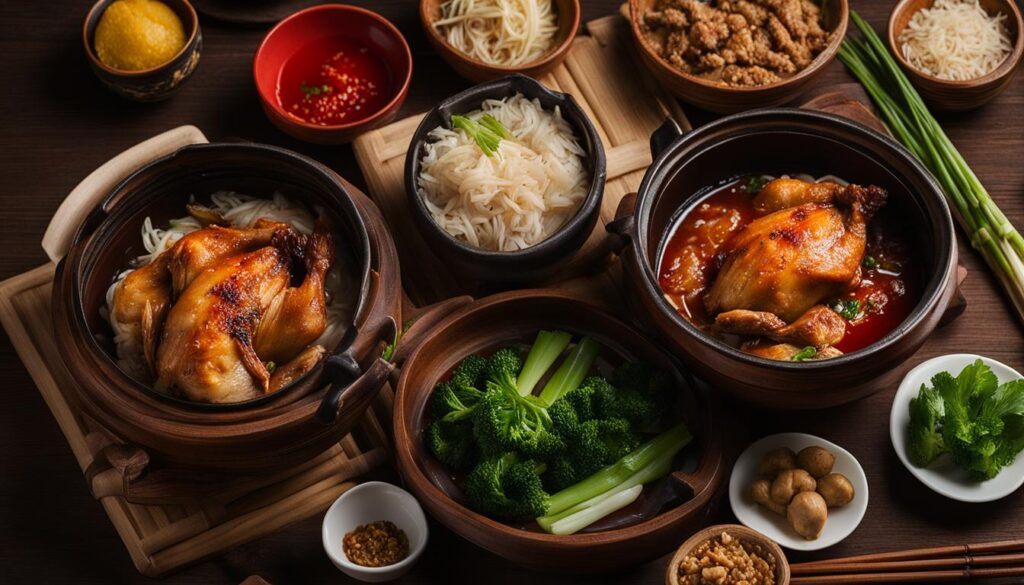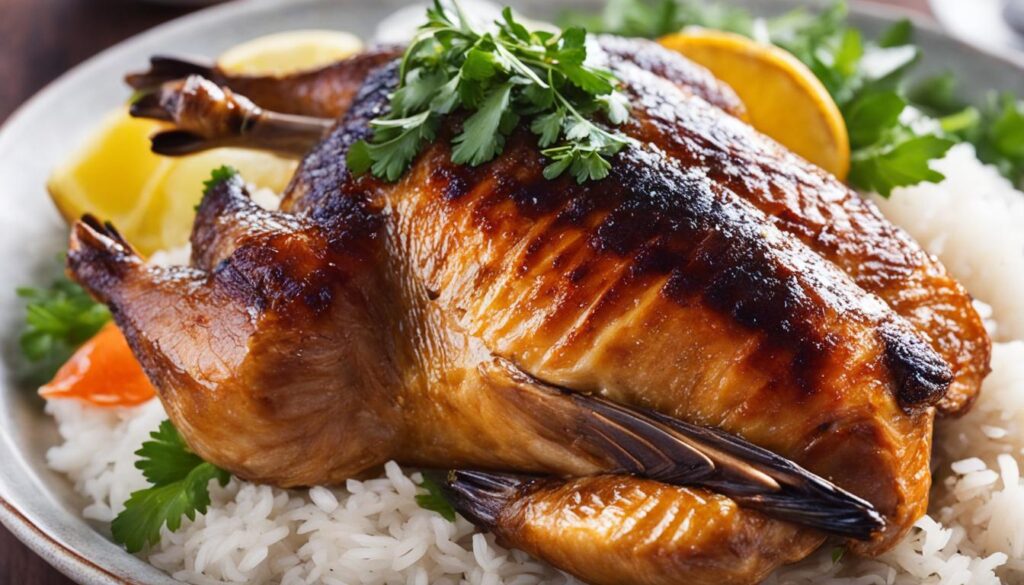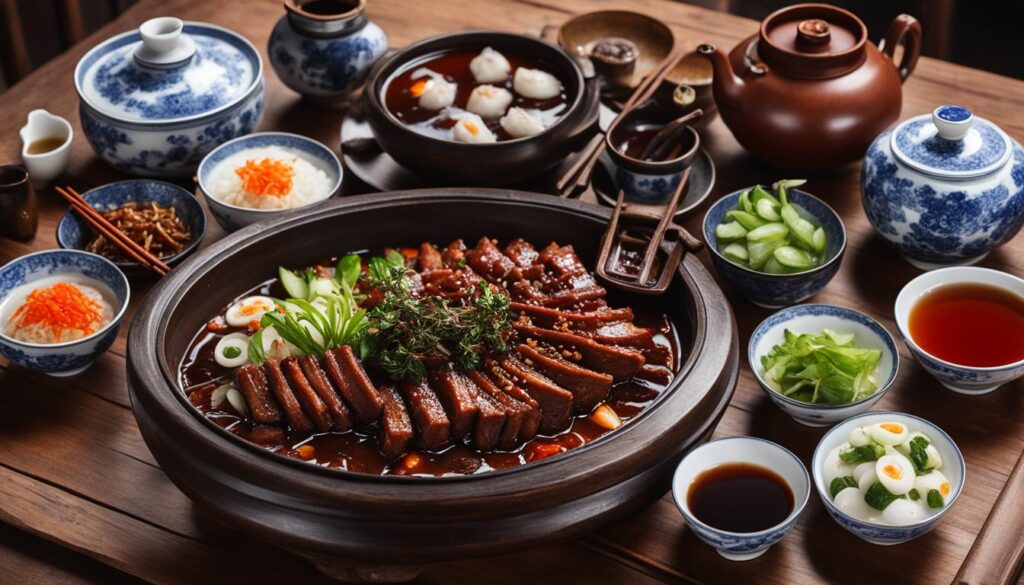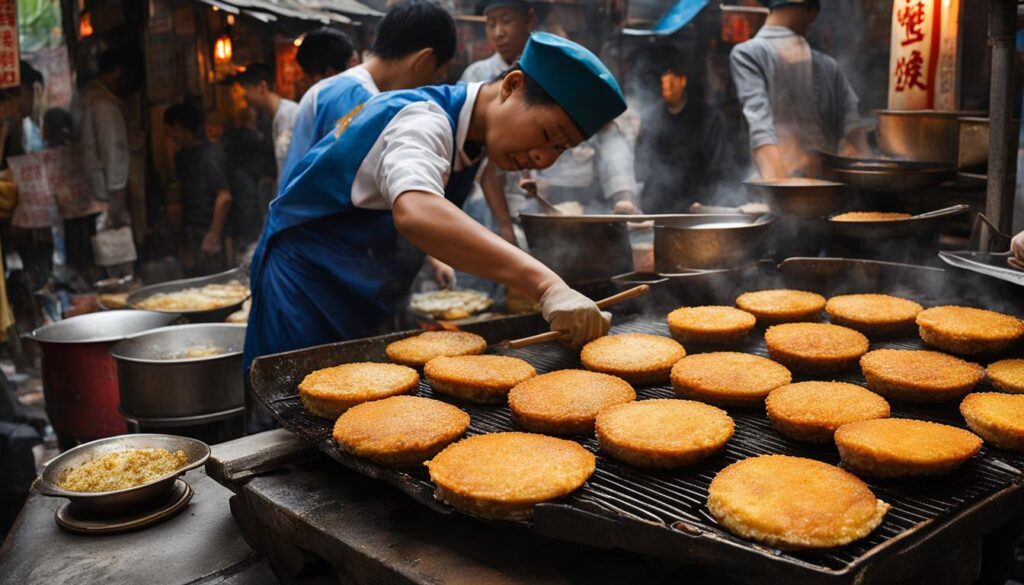Are you tired of ordering the same old xiaolongbao and shengjianbao every time you visit a Shanghainese restaurant? Then it’s time to broaden your culinary horizons and explore the lesser-known Shanghainese dishes that are just waiting to be discovered.
Shanghainese cuisine boasts a plethora of unique dishes that are often overshadowed by the popularity of the city’s most well-known delicacies. From savory Braised Lion’s Head Meatballs to sweet Eight Treasures Sticky Rice Balls, the options are endless.
In this article, we will take you on a culinary journey through the hidden gems of Shanghainese cuisine, introducing you to the authentic flavors and cultural significance of lesser-known dishes. So put down your chopsticks and get ready to indulge in a new world of culinary delights.
Braised Lion’s Head Meatballs (Shizi Tou)
Step into the world of Shanghainese cuisine and savor the flavors of Braised Lion’s Head Meatballs. This traditional Shanghainese dish is prepared with ingredients like ground pork, bamboo shoots, and water chestnuts. The meatballs are flavored with soy sauce, ginger, and Shaoxing wine, then slowly braised until tender. The result is a succulent dish that will transport you to the heart of traditional Shanghainese cooking.
One of the secrets to making the perfect Braised Lion’s Head Meatballs is in the preparation of the meat. The ground pork needs to be tenderized with water and seasoning prior to the addition of other ingredients. After shaping the meatballs, they are pan-fried until crispy and golden brown, giving them a delicious texture that contrasts beautifully with the rich sauce.
The gravy used to braise the lion’s head meatballs is also a significant element of this dish. It consists of soy sauce, dark soy sauce, rock sugar, and a mix of spices that infuse the meatballs with intense, savory flavors. The dish is traditionally served with bok choy or some other type of leafy greens, which helps cuts through the richness of the meat.
| Ingredients | Utensils |
|---|---|
|
|
If you’re looking for a way to experience the authentic taste of Shanghainese cuisine, prepare Braised Lion’s Head Meatballs using our authentic Shanghainese recipe. You won’t be disappointed!
Drunken Chicken (Zui Ji)
Have you heard of Drunken Chicken? This hidden gem in Shanghainese cuisine is a must-try for anyone looking to explore the authentic flavors of Shanghai. The dish consists of tender chicken, marinated in Shaoxing wine, that is served cold, allowing the flavors to mature and meld together.
The origins of the name are as interesting as the dish itself. According to legend, a drunken man stumbled into a restaurant and put a chicken in the rice wine. The cook then realized that the wine had infused the chicken with a delicious flavor and the dish was born.
| Ingredients | Cooking Method |
|---|---|
| Chicken thigh or drumstick | Cook the chicken in hot water, then cool and shred the meat. Combine with a marinade of Shaoxing wine, ginger, scallion, and salt. Refrigerate for at least 12 hours before serving. |
| Shaoxing wine | |
| Ginger | |
| Scallion | |
| Salt |
As a popular appetizer, Drunken Chicken can be found in many Shanghai restaurants, but it is often served as part of a cold appetizer platter. It’s the perfect dish to start your culinary journey through traditional Shanghainese food, a true hidden gem in Shanghai’s diverse cuisine.
Salted Duck (Yan Rou)
Looking for a unique Shanghainese dish? Look no further than Salted Duck, a traditional and lesser-known food that is sure to impress your taste buds. Made through a curing process, the duck meat is infused with various flavorful ingredients that give it a distinct taste and tender texture.
The curing process varies based on the recipe, but it typically includes salt, soy sauce, and Shaoxing wine. Once the duck meat is cured, it can be served in various dishes or enjoyed on its own. One popular dish is Braised Salted Duck with taro, which is a classic Shanghai main course.
Despite being less popular than some other Shanghainese dishes, Salted Duck remains a favorite among locals who appreciate its unique flavor.
Why You Should Try It
If you’re looking for authentic traditional Shanghainese food, Salted Duck is a must-try. Its unique curing process and flavors make it a standout dish in the region.
Where to Find It
Salted Duck can be found in select restaurants throughout Shanghai. One highly recommended spot is Fu Chun Teahouse, a renowned restaurant that serves up authentic Shanghainese cuisine.
Red-braised Pork (Hong Shao Rou)
One of the most loved traditional Shanghainese dishes is Red-braised Pork, a delightful blend of savory and sweet flavors. The dish consists of chunks of fatty pork belly that are braised in a rich, caramelized sauce made with soy sauce, sugar, and Chinese spices.
The key to achieving the perfect texture and taste is to braise the pork belly slowly over low heat until it becomes tender and succulent. The result is a melt-in-your-mouth experience that will leave you craving for more.
Red-braised pork is a popular dish among locals and tourists alike, with many variations available in Shanghainese restaurants. It’s commonly served as a main dish accompanied by steamed buns or rice, but can also be used as a topping for noodles or vegetables.
Discover the true essence of traditional Shanghainese food with this authentic Shanghainese recipe for Red-braised Pork:
Red-braised Pork Recipe
Serves: 6
Ingredients Instructions
- 1.5 pounds pork belly, cut into chunks
- 2 tablespoons oil
- 1 cup Shaoxing wine
- 1 cup water
- 1/4 cup soy sauce
- 1/4 cup dark soy sauce
- 1/3 cup sugar
- 1 cinnamon stick
- 3 star anise
- 3 cloves garlic, chopped
- 2 green onions, chopped
- 1 piece peeled ginger, sliced
- Preheat oven to 325°F (165°C).
- Heat oil in a large pot over high heat. Add pork belly and cook until browned on all sides, about 5 minutes.
- Add Shaoxing wine, soy sauce, dark soy sauce, cinnamon stick, star anise, garlic, green onions, ginger, and water. Stir until well combined. Bring to a boil.
- Transfer the mixture to an oven-safe baking dish. Cover with lid or aluminum foil and bake for 2 hours, stirring occasionally.
- Remove the cover and cook for another 30 minutes until the sauce becomes thick and sticky.
- Serve hot with steamed buns or rice.
Scallion Oil Noodles (Cong You Ban Mian)
Have you heard of Scallion Oil Noodles? This dish is a hidden gem in Shanghainese cuisine, and it’s a must-try for anyone looking for unique Shanghainese dishes. Made with simple ingredients like scallions, noodles, and oil, this dish combines flavors in a way that is both elegant and comforting.
The art of making the perfect scallion oil is what sets Scallion Oil Noodles apart from other dishes. By slowly cooking the scallions in oil, the flavors infuse to create a deliciously fragrant and savory oil that perfectly complements the springy noodles. This dish is a beloved street food in Shanghai, and it’s easy to see why!
Indulge in this delicious dish and experience the hidden gem of Scallion Oil Noodles.
Crab Shell Cake (Pai Dan Gao)
When it comes to Shanghai street food, Crab Shell Cake may not be the first dish that comes to mind. However, this lesser-known Shanghai street food has become a famous Shanghainese dish among food enthusiasts for its unique texture and flavor.
Pai Dan Gao is made from crab meat and flour batter that is cooked in crab shells, creating a delicate balance of textures and flavors that is unlike anything else. The dish is a popular snack found in local street markets and is a favorite among locals and tourists alike.
To make Crab Shell Cake, the crab meat is mixed with seasoning before being wrapped in a layer of flour batter. The mixture is then placed in crab shells and steamed until cooked through. The result is a soft, spongy texture that is complemented by the sweet and savory flavors of the crab meat.
If you’re looking to experience the essence of Shanghai street food, be sure to try Crab Shell Cake for yourself and taste the unique flavors that have made it a famous Shanghainese dish.
Stewed Duck’s Blood Soup (Ya Xie Tang)
Get ready for an adventure and indulge in the bold flavors of Stewed Duck’s Blood Soup, a hidden gem in traditional Shanghainese food. This unique dish showcases the adventurous side of Shanghainese cuisine with its diverse ingredients and cultural significance.
Made with duck blood, tofu, pork belly, and a variety of spices, this dish is a culinary experience you don’t want to miss. The addition of duck blood gives the soup a distinctive flavor and a rich, velvety texture that is sure to tantalize your taste buds.
In Shanghai, Stewed Duck’s Blood Soup is often enjoyed during the cold winter months as a nourishing and warming meal. The soup is believed to have medicinal properties that boost circulation and fight off colds and flu.
If you’re feeling adventurous and want to try a Shanghainese dish that is uniquely delicious, Stewed Duck’s Blood Soup is a must-try.
Eight Treasure Rice (Ba Bao Fan)
Indulge in the authentic flavors of traditional Shanghainese food with Eight Treasure Rice, a beloved dessert that is as delicious as it is symbolic. Made with eight essential ingredients that represent different meanings, this dessert symbolizes good luck and abundance for those who partake in it.
The eight ingredients that make up this dessert include glutinous rice, sugar, red bean paste, sticky lotus seeds, jujube date, raisins, Chinese chestnuts, and osmanthus flowers. Each ingredient adds its unique flavor and texture, creating a harmonious blend that is a feast for the senses.
This authentic Shanghainese recipe has been passed down through generations, and it’s easy to see why it has stood the test of time. The sticky, sweet rice is infused with the fragrance of osmanthus flowers and enriched with the creaminess of red bean paste, creating a delightful ending to any Shanghainese meal.
When in Shanghai, make sure to try Eight Treasure Rice to experience the traditional Shanghainese food culture in its full glory.
Yellow Croaker in Sweet and Sour Sauce (Jiang Su Yu)
Explore the unique Shanghainese dishes and add the Yellow Croaker in Sweet and Sour Sauce to your list. This delectable seafood dish is a treat for your taste buds, with a perfect balance of tangy and sweet flavors, and a crispy exterior that complements the tender flesh of the croaker.
To achieve this delicious balance of flavors, the traditional recipe calls for a mix of rice vinegar, soy sauce, sugar, ginger, and garlic. The croaker is first coated with cornstarch and fried until crispy. The sweet and sour sauce is then poured over the fish and garnished with green onions and red peppers.
Experience the authentic Shanghainese recipe, and indulge in the unique flavors of this Shanghainese delicacy.
Eight Treasures Sticky Rice Balls (Tang Yuan)
End your culinary journey on a sweet note with Eight Treasures Sticky Rice Balls. These famous Shanghainese dishes are beloved during festivals and celebrations. Sometimes referred to as Tangyuan, these sweet rice balls can have a range of fillings, from red bean paste to sesame to peanut butter. The varied ingredients represent the eight treasures, symbolizing good luck and abundance.
In the past, Eight Treasures Sticky Rice Balls were made exclusively for the Winter Solstice Festival, also known as Dongzhi. According to traditional Chinese medicine, Dongzhi represents yin and the arrival of winter. Therefore, eating Tangyuan during this time symbolizes the balance between yin and yang. Nowadays, these delicious balls are enjoyed year-round and can be found in most Chinese dessert shops.
Conclusion
Now that you have explored the lesser-known Shanghainese dishes beyond the popular favorites, you have uncovered the hidden gems of Shanghainese cuisine. From the traditional flavors of Braised Lion’s Head Meatballs and Salted Duck to the unique taste of Scallion Oil Noodles and Crab Shell Cake, you have expanded your culinary horizons.
As you have discovered, Shanghainese cuisine is diverse and rich in cultural significance. Each dish tells a story, and each bite takes you on a journey of flavor. Whether you’re looking to try something new or revisit old favorites, Shanghainese cuisine has something for everyone.
So next time you’re in the mood for a culinary adventure, don’t forget to explore the hidden treasures of Shanghainese cuisine. Who knows? You might discover your new favorite dish.

















































